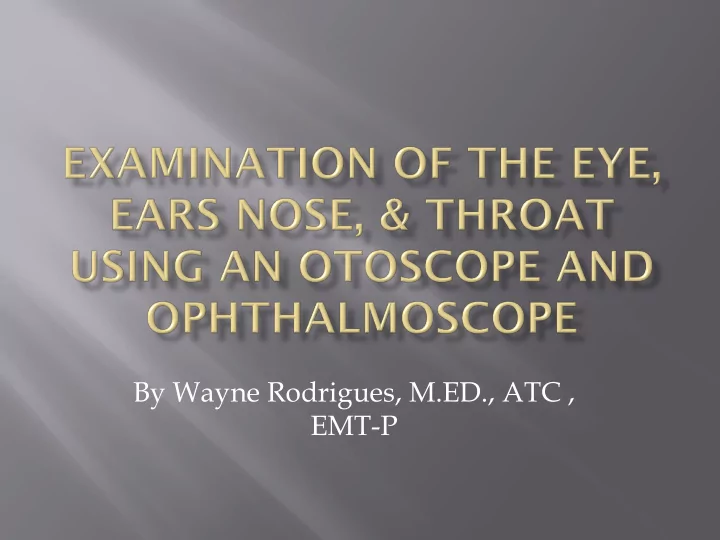

By Wayne Rodrigues, M.ED., ATC , EMT-P
Purpose is to look for Fluid Perforations Foreign Objects Excessive Cerumen Inflammation Redness Swelling Cuppett, 2012
Translucent Pearly gray in color Concave in nature Cuppett, 2012
Otitis Media Viral infection of the middle ear Often accompanies upper respiratory problems Signs and symptoms ear pain w/out tenderness to touch, fever, pressure- feeling, loss of hearing and dizziness Required referral and treated with antibiotics and analgesics O’Conner, 2008 http://www.hearingprofessionals.co.nz/Images/The-Human- Ear.gif
MOI: Growth of bacteria or fungus in outer ear resulting in outer ear infection. Predisposing factors: dark wet environment and/or over- cleaning ears. S/s: C/c constant pain and pressure in ear w/ associated itchiness. May c/o of hearing loss, dizziness. Ear canal appears red and irritated upon inspection. (+) Tug Test Mgt: Refer for physician evaluation www.fpnotebook.com/ EntOtomycosis.jpg Antibiotics Cuppet, 2012
Symptoms are similar to otitis externa: Canal swelling & errythemia itching, pain and decrease in hearing, May be removed either by physician with tool or suctioning the object. http://images.medicinenet.com/images/illustrations/ear_wax.jp http://stallgeriatrics.com/education/KeyPrinciple2-EarWax.jpg
Normal Soft Cerumen Impacted soft brown cerumen Veil of cerumen eac.hawkelibrary.com/
MOI: Sudden change in air pressure or impaled object S/s: Excruciating pain in middle ear that radiates. Tinnitus. Marked loss of hearing, transient dizziness. Blood or fluid may be viewed escaping from the ear or viewed through otoscope. Any fluid noted in the ear canal be should be a red flag indicating rupture. Mgt: Potential for associated basilar skull fx depending on MOI. Cover with sterile gauze, and immediate referal.
Traumatic perforation Subtotal perforation of the tympanic membrane insect (ant) in external auditory meatus, www.rcsullivan.com/ www/forum/zlinsky/glueear1.jpg
MOI: direct blow S/s: May or may not have deformity but bleeding usually present. Signs of direct trauma. Ecchymosis, and swelling often present. C/c is pain on and around the nose MGT: ice, stop bleeding and refer Cuppett, 2012
MOI: direct blow S/s: Same as those associated with nasal fracture. May have difficulties breathing through involved side. MGT: Same as with nasal fracture Cuppett, 2012
Caused by: Previous surgery Trauma Cocaine Use Excessive nose picking Cancer & other diseases Complications: Pain, bleeding, & whistling sound Treatment: Small: Saline solution & lubricating gels Large: Surgery http://www.webmd.com/allergies/tc/repair- of-nasal-septal-perforation-surgery-overview
Soft painless, non cancerous growths within nasal lining. Caused by: Inflammation, Asthma, reoccurring infections, immune disorder May lead to breathing problems, Chronic infections Treated with Meds and or surgery http://www.mayoclinic.com/health/nasal-polyps/DS00498
Fungal infection involving mucous membranes in mouth. Caused by fungus Candida alicans which is caused from antibiotics use and immunosuppression. Signs and symptoms include creamy white plague on tongue, cheeks and palate which later develop into lesions. Treat with topical or systemic antifungal medications Cuppett, 2012
Gingivitis-swollen, red, or bleeding gums Sensitivity to Hot or Cold Beverages caused from teeth demineralization http://www.blogaholics.ca/wp/uploads/illu_mouth.jpg Halitosis (Bad breath)-poor dental hygiene and periodental disease Plaque-fungal infections such as candidiasis http://www.acm.uiuc.edu/sigbio/project/digestive/early/mouth.jpg
Pharyngitis and Tonsillitis produce throat pain, pain swallowing, and pain in the ears when swallowing Pharyngitis (Strep Throat) Inspection: Erythematous in the throat with mucoid covering the pharynx. Tonsillitis Inspection: Inflamed tonsils Laryngitis: causes changes in voice , hoarseness or complete inability to speak. Fever or dyspnea may occur. Upon inspection may notice purulent exudate on larynx. O’Conner, 2008
Position patient in seated position with head turned downward and away. Select the largest speculum that can be comfortably inserted in ear Hold Otoscope in the same hand as the ear you examine. “Right to Right , Left to Left” Rest ring & Little finger on patient’s cheek. Pull the Pinna up & backwards to straighten canal Watch your way into ear canal, never insert blindly. Inspect the Tympanic Membrane Cuppett, 2012
Rotate speculum to view all corners of the membrane and ear canal. Inspect the membrane for Color Clarity Position Use of Otoscope http://www.youtube.com/watch?v=FqSCfqoCNiI Cuppett, 2012 https://www.google.com/search?q=Use+of+Otoscope&client
Allergies are typically bilateral, infection is unilateral Infectious conjunctivitis will spread quickly Treatment: Referral for antihistamine (allergy) or antibiotics (infection) Eye infections with severe px or photophobia may be more severe (Corneal http://www.healthanswersboard.com/blog/wp-content/uploads/2008/05/pink- injury or a herpes viral eye.jpg infection) O’Conner, 2008
Blood in the anterior chamber of eye. Caused by blunt trauma. Signs & Symptoms: Pain, Bleeding Blurred Vision Treatment: http://www.kellogg.umich.edu/theeyeshaveit/trauma/images/hyphema.jpg Keep Head Elevated Immediate referral to specialist Cuppett, 2012
Bleeding under the conjunctiva Caused by trauma, forceful cough, high BP, bleeding disorders Treatment: Resolve in 1-3 weeks Lack of trauma = normally benign O’Conner, 2008 http://www.tedmontgomery.com/the_eye/eyephotos/pics/SubconjunctivalHe morrhage.jpg
Most common sports eye injury Direct trauma from outside object Object caught and rubbed What are the signs and symptoms http://www.eyedoctom.com/eyedoctom/EyeI nfo/Images/CornealAbrasion.jpg associated with this pathology? O’Conner, 2008
MOI:Forceful jarring, strong sneeze, no known cause. Sx: Floaters, halos, blind spots, curtain falling over vision http://graphics8.nytimes.com/images /2007/08/01/health/adam/9931.jpg Treatment: Referral to ophthalmologist O’Conner, 2008
Chronic eye disease causing central field of vision loss. Dry Degeneration More common Age related Wet Degeneration Blood vessels under the retina begin leaking blood and fluid. Refer to Ophthalmologist https://www.google.com/search?q=macular+degeneration http://www.mayoclinic.com/health/macular- degeneration/DS00284
https://www.google.com/search?q=macular+degeneration&clien http://www.hollows.org.au/eye-health/macular-degeneration
http://www.youtube.com/watch?v=wPzCA9k8GRQ
Cuppett, M., Walsh, K.M. (2012) General Medical Conditions in the Athlete (Second Edition) Elsevier-Mosby O'Connor, D. P., Fincher, A. L. (2008). Clinical Pathology for Athletic Trainers: Recognizing Systemic Disease (Second ed.). Thorofare, NJ: SLACK Incorporated.
Extra and or Unusual Sounds during a heart beat Range fro very faint to load May hear a swishing or whooshing sounds Classified as innocent(harmless) or Abnormal http://www.nhlbi.nih.gov/health/health-topics/topics/heartmurmur/
INNOCENT ABNORMAL Children’s murmurs Common in healthy typically caused by children heart defects at birth Are not due to heart Adult murmurs are problems caused by an acquired May have been heard heart valve disease by child’s pediatrician Typically will display as some point signs and symptoms of heart disease
Auscultation of Heart Sounds and Murmurs
Cuppett, M., Walsh, K.M. (2012) General Medical Conditions in the Athlete (Second Edition) Elsevier-Mosby http://www.youtube.com/watch?v=39n4XWv 7flQ http://www.nhlbi.nih.gov/health/health- topics/topics/heartmurmur/ http://www.youtube.com/watch?v=ax9B6g6g EOc
Recommend
More recommend